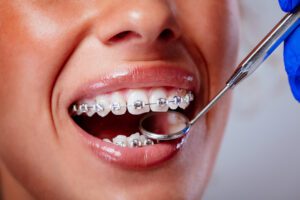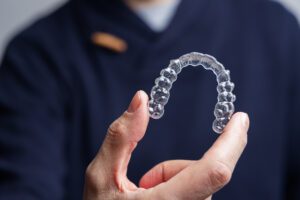Posted on May 1, 2023

Are you considering orthodontic treatment such as braces or Invisalign? You’re not alone; nearly four million Americans undergo braces treatments each year. But with so many choices, how do you choose the best option for your teeth?
Braces and Invisalign are among the two most popular forms of orthodontic treatment available today. Traditional braces have been around for decades, while Invisalign offers an increasingly popular alternative to metal brackets. Each has its own benefits and drawbacks.
When deciding between braces vs. Invisalign, it’s important to consider your budget, lifestyle, dental history, health condition, and desired results.
To properly evaluate which option is best for you, it is helpful to understand more about each treatment method.
In this article, we will explore the relative advantages and disadvantages of each type of orthodontic treatment.
Braces work by applying gentle, constant pressure to the teeth and jaws. This force encourages them to adjust to a better position over time.
Brackets are attached to the front of each tooth, and an archwire is then connected to all of the brackets with ligatures or rubber bands. The archwire will act as a track on which the teeth can move.
The tension created by tightening springs and rubber bands applies pressure which helps guide the teeth into a more symmetrical alignment. Throughout treatment, patients may need periodic visits for adjusting their braces during which tension is increased or released so that the teeth can move in an optimal way.
Benefits of Braces
Braces are one of the oldest forms of orthodontics, and they continue to be a popular option for aligning teeth today. Although braces can feel annoying at times, there are numerous benefits to having them.
Here are just a few of the many benefits of braces that you should consider when considering this orthodontic treatment.
When teeth are crowded or misaligned, it can make them difficult to brush and floss effectively. This increases your risk of developing cavities or gum disease since dental plaque and bacteria can settle in hard-to-reach areas between your crooked or overlapping teeth.
Orthodontic treatment with braces will reposition your teeth so you’ll be able to clean between each tooth accurately and effectively.
A poor bite, also known as malocclusion, is an alignment problem with your top and bottom row of teeth where the upper and lower rows don’t fit together properly when you bite down.
Braces work by using gentle pressure over a period of time to move your teeth into their correct positions which will result in better jaw alignment when biting down.
It might seem trivial, but having a properly aligned set of teeth makes chewing food much easier than having an underbite, overbite, or crossbite issue that won’t let you chew efficiently.
It’s no secret that having straighter, more evenly spaced teeth can make us look more attractive—and everyone could use some help boosting their self-confidence!
Straighter teeth may be perceived as healthier by others because they clearly convey that we take good care of our oral health on a regular basis (which we should!).
Crowded or overlapped teeth put us at risk for gum diseases like gingivitis since food particles get stuck in hard-to-reach spots where brushing and flossing can miss residual plaque buildup if not cleaned correctly every day.
Having overcrowded upper and lower surfaces creates pockets between our gums which traps bacteria along the edge – leading to inflammation and tenderness in our gums plus potential bleeding too – both indicators of possible gum disease if gone unchecked.
Orthodontic treatment with braces helps reduce these issues by making it so much easier to clean all surface areas adequately through straightening action
Crooked or unevenly spaced teeth can cause stress on our lower jaw joint – also known as TMJ disorder – due largely to clenching/grinding habits. Braces can greatly reduce stress and provide comfort.
Braces are a great way to achieve a beautiful smile, but they come with some drawbacks. From possible discomfort to a longer treatment time, here’s what you should know about the drawbacks of braces before opting for orthodontic treatment.
When it comes to getting braces, your timeline may not be as short as you think. Depending on your course of treatment, it could take months or even years for braces to produce their desired effects. That’s why it’s important to speak with your orthodontist about the expected duration of your treatment and plan accordingly.
Any dental procedure can be uncomfortable – and braces are no exception. Throughout the course of your treatment, you may experience soreness in the area around the brackets and teeth. Over-the-counter pain medications may help reduce this discomfort until it is resolved naturally over time.
If not properly cared for, braces can cause teeth displacement and further correction complications in the future. Make sure that you diligently follow all guidelines given by your orthodontist if you want to prevent such problems from occurring down the line.
In some cases, metal brackets or wires used for braces can irritate or cut into oral tissues like tongues and lips.
While these irritations usually heal on their own within a few days after placement, catch them early by being vigilant about monitoring changes inside your mouth – especially when making adjustments or tightening existing brackets or wires.
During orthodontic treatments like brace systems, there is an added difficulty to proper oral hygiene because flossing and brushing become more complex due to all the extra hardware involved – including brackets and wiring that must be cleaned daily at home as well as during regularly scheduled appointments with an orthodontist.
Poor oral hygiene led by shortcutting these steps can result in decay around the current tooth structure and lead to additional corrective procedures in the future outside typical routine treatments.
Invisalign uses a series of custom-made, invisible aligners to gradually move teeth. Each aligner is designed based on the patient’s digital scan and corrective treatment plan by orthodontists. The patient simply wears each set of aligners for two weeks before advancing to the next one in sequence.
This gradual movement helps reduce discomfort and can be used to correct misalignment, crowding and other dental issues.
Invisalign can achieve similar results as traditional braces without the need for bulky metal wires and brackets, making them virtually invisible while in use.

Invisalign aligners have no wires or brackets like traditional braces. Instead, they use smooth plastic aligners that fit snugly over your teeth with no extra bulk or poking pieces that could irritate the soft tissues of your mouth.
Unlike traditional braces, you can easily remove and replace your Invisalign trays when necessary.
This makes brushing and flossing much easier because you don’t have to worry about maneuvering around bulky pieces of hardware or worrying about food particles becoming trapped in brackets and wires.
A major benefit of Invisalign is its discreet nature; The clear plastic trays make it almost impossible for people to tell when you’re wearing them, letting you straighten your smile without drawing unwanted attention. which is great if you want to maintain a professional image while wearing braces!
When it comes time to eat and drink, traditional braces often get in the way as food particles can become stuck in between brackets and wires.
With Invisalign aligners, however, all you have to do is take them off before eating – no more picking out bits of food stuck on your wiring. Plus they pop back in just as easily!
The biggest issue with traditional braces is their frequent adjustments which cause discomfort throughout each visit – not fun!
With Invisalign however, few adjustments are needed which makes each visit short and sweet – resulting in less pain overall than with regular braces.
Not only does this save time but also costs money as fewer trips are needed for routine check-ups or fixes.
Although it is an attractive option for many because of its convenience and the fact that it is nearly invisible, there are some drawbacks of Invisalign treatment that must be considered before deciding if it’s the right choice for you.
Many patients experience increased sensitivity in their teeth after beginning Invisalign treatment due to the shifting of the teeth during alignment. This can make eating and drinking foods like ice cream and cold drinks uncomfortable or even painful.
Your dentist may recommend special toothpaste or rinses to help mitigate this symptom, but additional oral care may still be necessary to ensure your mouth stays healthy and comfortable throughout your treatment period.
One of the most commonly cited drawbacks of Invisalign treatments is its cost. Compared with traditional braces, Invisalign can be anywhere from two to four times more expensive – depending on the complexity of your individual case as well as other factors such as dental insurance coverage and location.
Unlike traditional braces, which have metal bands attached to each tooth, removable aligners can cause food particles and debris to get trapped inside them when they’re not being worn.
And because they’re made from a lightweight flexible material with no sharp edges, they can sometimes be difficult (or impossible) for patients to remove them on their own if something does become lodged in there.
In rare cases, improper handling or removal of the clear aligner trays have been known to cause damage or trauma to a patient’s teeth — something that doesn’t usually happen with regular braces since they’re “glued” into place using cement or some other adhesive material along with metallic brackets and wires.
Therefore, it’s important for you to pay close attention throughout your treatment process so you don’t inadvertently do anything that could lead to permanent damage over time.
Professional advice for teeth alignment is a must for anyone considering going the orthodontic route.
Not only is it important to find the best procedure that works for you, but professional advice can provide insight into factors such as the time frame needed to achieve desired results, possible side effects, and long-term maintenance upkeep needed to maintain teeth alignment after the initial treatment.
The right professional like Smilebliss can make all the difference in having a successful teeth alignment procedure. To know more about your dental options, contact us at Smilebliss.